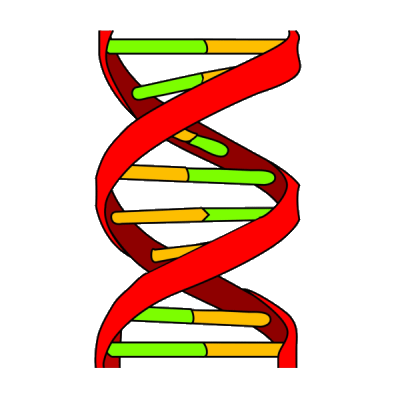Genetics and Gender


My last article was only an introduction and didn’t carry much substance with it. I hope to rectify that with this article. Strap yourself in, because I’m about to dispense a whole lot of science. Bear with me on this for just a bit; I have a purpose in mind.
My early years were characterized by a fascination with genetics, the study of the chemical basis for physical traits being passed from parent to child[1]. I mentioned genetics in a speech at my sixth grade graduation; I built a model of DNA in high school; and I began my undergraduate study intending to work in genetics for the rest of my life. I did not end up working as a geneticist, but I will begin to lay a foundation for a theory of the transgender experience, and genetics is a good place to start.
What is Genetics?
Above, I called genetics the study of the chemical explanation for how physical traits are passed from parent to child. Genetics attempts to explain how you got your mother’s rheumy eyes or your father’s weak chin. At its base, genetics is a study of probability: it is likely that not all of your siblings got the same eyes and chin. It takes genetic material from both your mother and your father to combine in you to give you such…er…distinctive features, and sometimes certain genetic material combines well, sometimes it combines poorly.
Way back in the Olden Days of The 19th Century, a scientist / part-time monk named Gregor Mendel[2] spent his time breeding pea plants and observing how certain physical traits of parent pea plants were passed on when their seeds grew up into child pea plants. (Remember this story when you bemoan how your hobbies are “kind of boring.”)
Mendel observed that he could predict the expression of some traits — in particular, color of the seed (yellow or green) and skin of the seed (smooth or wrinkled). He observed that green peas only occurred when a green-pea daddy gave pollen to a green-pea mommy’s flower. Otherwise, the peas would be yellow. Mendel called greenness a “recessive” trait (because it took both parents to express it) and yellowness a “dominant” trait (because it dominated the observed expression of pea color). And that, folks, is the birth of genetics!
A side note in the development of evolutionary theory is Jean-Baptiste Lamarck[3], found pretty much nowhere in the history of genetics. Larmarck postulated that if a parent performed an action enough times, the trait could be passed on to children. He called his postulate “acquired character,” because the trait in question was passed on after having been acquired by the parent. The canonical example of Lamarck’s postulate is the long neck on giraffes. When two parent giraffes stretch their necks to eat leaves, children of those stretchy-neck giraffes also have stretchy necks. I guess it made sense at the time.
Do All Traits Get Passed to Children?
Despite Lamarck’s acquired characteristics ultimately falling to Darwin’s natural selection[4], a good question to ask is “what traits can be passed from parent to child?” Mendel observed pea color, and I certainly can see the worst features of my parents in myself, but how far does that go? What about politics? Psychology? Karma? Bad Hair Days?
To begin to answer this question, we need to discuss what biochemical process is responsible for things like rheumy eyes, weak chins, and bad hair days. That process begins with a compound known as deoxyribonucleic acid (DNA). As microscopes continued to improve, scientists observed that large biological organisms were composed of small nuggets that they named cells. Some cells have a defined nucleus in them, and it is in the nucleus that big strands of DNA were discovered.
I want to wave my hands a little bit at this point to say that DNA, its structure, and how all of that was discovered is a relatively recent story, beginning in earnest around the 1950s. There is a good synopsis of the history here[5], and if you would like to know more about the really, really low level of genetics, I recommend reading that set of web pages and branching out from the links listed at the end. In the meantime, I want to move on to how these long strands of DNA turn into the study of genetics.
From DNA to Gene to Chromosome to Genome
DNA exists as long strands in the nucleus of a cell, but the strands are organized in most organisms. A particular chunk of a strand — a sequence of base pairs — is called one single gene. These chunks are responsible for encoding how your biochemistry works and how your body gets built. Organisms tend to group several strands of DNA (and their associated collection of genes) into a structure called a chromosome, which is much more easily observed in a microscope than a single molecule of DNA. Organisms typically possess more than one chromosome, and the group of chromosomes is named the genome of the type of organism. For instance, humans possess what is known as “the human genome[6].”
It is important to point out that — while I claimed that a particular chunk of DNA is a gene — many of those genes are interrelated. Most biological functions are built from several types of biological molecules, which means that several genes are required to express a trait in the way that it is expressed. To give an idea of the scope of the complexity, each strand of DNA can easily contain hundreds of thousands of base pairs. Each collection in a chromosome, then, could easily contain tens of millions of base pairs, and the entire genome contains an almost unfathomable amount of information that describes how the organism possessing it is built. The number of base pairs that comprise the human genome is listed at 3,117,275,501[7]. It takes a minimum of three base pairs to make a gene (and that would be a pretty measly gene), and it is estimated that humans have between 20,000 and 30,000 genes. Although not every gene affects every other, that is still a significant number of genes, and their interrelationships is what makes humanity so diverse…and so fragile.
Determining Sex of a Human from Chromosomes
One extremely obvious trait that was correlated with chromosomes is sex. To be clear, I mean the primary and secondary sex characteristics that are observed in humans: things like a penis or a vagina, breasts or a beard (I make this distinction because it brings up an important point that I will get to in time). These were correlated to two chromosomes — namely, the X and the Y chromosome. Humans that possessed a vagina and breasts were typically observed to possess two X chromosomes, or XX. Humans that possessed a penis and facial hair were typically observed to possess one X chromosome and one Y chromosome, or XY. These physical traits were attributed to sex labels — female for XX and male for XY.
I hope that the above discussion about the amount of genetic material in the human genome has at least made you question whether using two chromosomes to characterize the sex of a human is somewhat of a blunt instrument. There are many, many subtleties in genetics, especially when there are so many genes in the genome, that using two large group of genes (many of which do not contribute to primary or secondary sex characteristics) is problematic. I will have more to say about intersex characteristics[8] in a later article, which throws an entirely different light on how the human genome operates in terms of expressing sex characteristics.
Say…Didn’t You Mention Gender…?
After all of this science stuff, you might be curious what genetics has to do with gender. After all, that was what the title said, right? Plus, the etymology of both genetics and gender stems from the Latin genus, meaning “type, kind, or species.” The usage in both cases seems clear. Genetics establishes a scientific basis for grouping plants and animals by general characteristics such as leaves, backbones, or the musculature to walk upright. Gender establishes a scientific basis for grouping plants and animals by sex characteristics such as genitalia.
Well…it turns out the truth is not quite that simple. Genetics also describes transmitting traits from parent to child. Can genetics explain the transgender experience, and is it passed from generation to generation? An interesting side note is that the word gender is also thought to derive from the proto-Indo-European root *gene-, which had to do with procreation[9] and tribal identity. So how did gender come to be differentiated from sex, which is what we discussed above? That will be the topic of the next article, as there is a significant misunderstanding of the original concept as it was intended almost 70 years ago.




